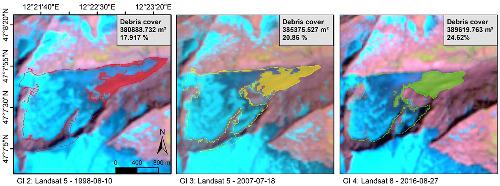当前位置:
X-MOL 学术
›
Earth Surf.Process. Land.
›
论文详情
Our official English website, www.x-mol.net, welcomes your feedback! (Note: you will need to create a separate account there.)
Evolution of debris cover on glaciers of the Eastern Alps, Austria, between 1996 and 2015
Earth Surface Processes and Landforms ( IF 3.3 ) Pub Date : 2021-01-02 , DOI: 10.1002/esp.5065 Fabian Fleischer 1 , Jan‐Christoph Otto 2 , Robert R. Junker 3, 4 , Daniel Hölbling 5
Earth Surface Processes and Landforms ( IF 3.3 ) Pub Date : 2021-01-02 , DOI: 10.1002/esp.5065 Fabian Fleischer 1 , Jan‐Christoph Otto 2 , Robert R. Junker 3, 4 , Daniel Hölbling 5
Affiliation

|
Debris cover on glaciers is an important component of glacial systems as it influences climate–glacier dynamics and thus the lifespan of glaciers. Increasing air temperatures, permafrost thaw and rock faces freshly exposed by glacier downwasting in accumulation zones result in increased rockfall activity and debris input. In the ablation zone, negative mass balances result in an enhanced melt-out of englacial debris. Glacier debris cover thus represents a clear signal of climate warming in mountain areas. To assess the temporal development of debris on glaciers of the Eastern Alps, Austria, we mapped debris cover on 255 glaciers using Landsat data at three time steps. We applied a ratio-based threshold classification technique and analysed glacier catchment characteristics to understand debris sources better. Across the Austrian Alps, debris cover increased by more than 10% between 1996 and 2015 while glaciers retreated in response to climate warming. Debris cover distribution shows significant regional variability, with some mountain ranges being characterised by mean debris cover on glaciers of up to 75%. We also observed a general rise of the mean elevation of debris cover on glaciers in Austria. The debris cover distribution and dynamics are highly variable due to topographic, lithological and structural settings that determine the amount of debris delivered to and stored in the glacier system. Despite strong variation in debris cover, all glaciers investigated melted at increasing rates. We conclude that the retarding effects of debris cover on the mass balance and melt rate of Austrian glaciers is strongly subdued compared with other mountain areas. The study indicates that, if this trend continues, many glaciers in Austria may become fully debris covered. However, since debris cover seems to have little impact on melt rates, this would not lead to prolonged existence of debris-covered ice compared with clean ice glaciers.
中文翻译:

1996 年至 2015 年间奥地利东阿尔卑斯山冰川碎片覆盖的演变
冰川上的碎屑覆盖物是冰川系统的重要组成部分,因为它会影响气候-冰川动态,从而影响冰川的寿命。气温升高、永久冻土融化和堆积区冰川消融导致新暴露的岩面导致落石活动和碎片输入增加。在消融区,负质量平衡导致冰川碎片的熔化增强。因此,冰川碎片覆盖是山区气候变暖的明确信号。为了评估奥地利东阿尔卑斯山冰川碎片的时间发展,我们使用 Landsat 数据在三个时间步长绘制了 255 条冰川的碎片覆盖图。我们应用了基于比率的阈值分类技术并分析了冰川集水区的特征,以更好地了解碎片来源。横跨奥地利阿尔卑斯山,1996 年至 2015 年间,碎片覆盖增加了 10% 以上,而冰川因气候变暖而退缩。碎片覆盖分布显示出显着的区域变异性,一些山脉的特点是冰川上的平均碎片覆盖率高达 75%。我们还观察到奥地利冰川上碎片覆盖的平均海拔普遍上升。由于地形、岩性和结构设置决定了输送到冰川系统和储存在冰川系统中的碎片数量,碎片覆盖的分布和动态变化很大。尽管碎片覆盖的变化很大,但调查的所有冰川都以增加的速度融化。我们得出的结论是,与其他山区相比,碎片覆盖对奥地利冰川的质量平衡和融化速率的阻碍作用明显减弱。研究表明,如果这种趋势继续下去,奥地利的许多冰川可能会完全被碎片覆盖。然而,由于碎片覆盖似乎对融化速率几乎没有影响,因此与干净的冰川相比,这不会导致碎片覆盖的冰的长期存在。
更新日期:2021-01-02
中文翻译:

1996 年至 2015 年间奥地利东阿尔卑斯山冰川碎片覆盖的演变
冰川上的碎屑覆盖物是冰川系统的重要组成部分,因为它会影响气候-冰川动态,从而影响冰川的寿命。气温升高、永久冻土融化和堆积区冰川消融导致新暴露的岩面导致落石活动和碎片输入增加。在消融区,负质量平衡导致冰川碎片的熔化增强。因此,冰川碎片覆盖是山区气候变暖的明确信号。为了评估奥地利东阿尔卑斯山冰川碎片的时间发展,我们使用 Landsat 数据在三个时间步长绘制了 255 条冰川的碎片覆盖图。我们应用了基于比率的阈值分类技术并分析了冰川集水区的特征,以更好地了解碎片来源。横跨奥地利阿尔卑斯山,1996 年至 2015 年间,碎片覆盖增加了 10% 以上,而冰川因气候变暖而退缩。碎片覆盖分布显示出显着的区域变异性,一些山脉的特点是冰川上的平均碎片覆盖率高达 75%。我们还观察到奥地利冰川上碎片覆盖的平均海拔普遍上升。由于地形、岩性和结构设置决定了输送到冰川系统和储存在冰川系统中的碎片数量,碎片覆盖的分布和动态变化很大。尽管碎片覆盖的变化很大,但调查的所有冰川都以增加的速度融化。我们得出的结论是,与其他山区相比,碎片覆盖对奥地利冰川的质量平衡和融化速率的阻碍作用明显减弱。研究表明,如果这种趋势继续下去,奥地利的许多冰川可能会完全被碎片覆盖。然而,由于碎片覆盖似乎对融化速率几乎没有影响,因此与干净的冰川相比,这不会导致碎片覆盖的冰的长期存在。

























 京公网安备 11010802027423号
京公网安备 11010802027423号